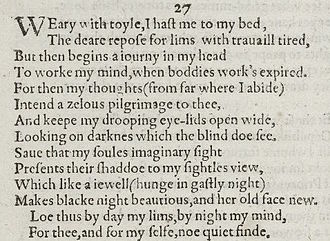Sonnet 27
| Sonnet 27 | |||||||
|---|---|---|---|---|---|---|---|
 Sonnet 27 in the 1609 Quarto | |||||||
| |||||||
Sonnet 27 is one of 154 sonnets published by William Shakespeare in a quarto titled Shakespeare's Sonnets in 1609. It is a part of the Fair Youth group of sonnets, and the first in a group of five sonnets that portray the poet in solitude and meditating from a distance on the young man. A theme of the first two of the group (sonnets 27 - 28) regards the night and restlessness, which is a motif also found in the sonnets of Petrarch.[2]
Analysis
[edit]In Sonnet 27 the weary poet cannot find rest — not day or night. He goes to bed weary after working hard, which is the "toil" of line one, and the "travail" of line two. As soon as he lies down, another journey begins in his thoughts ("To work my mind") — the destination is the young man, who is far from where the poet is ("from far where I abide"). The poet's thoughts take that journey, and though he sees nothing but the darkness of night, his imagination presents to him an image of the young man, an image that seems to hang before him in the dark, like a jewel. This vision makes the "black night" beautiful — the word "black" is equated with ugliness and "night" has a feminine aspect. The reader is led to expect this vision to improve the poet's lot, but the final couplet suggests that it only adds to the restless misery of the weary poet, and "no quiet" can the poet find.[3][4]
Structure
[edit]Sonnet 27 is an English or Shakespearean sonnet, which consists of three quatrains followed by a final couplet. It follows the rhyme scheme ABAB CDCD EFEF GG, and is written in iambic pentameter, a metre in which each line has five feet, and each foot has two syllables accented weak/strong. Most of the lines are regular iambic pentameter including line three:
× / × / × / × / × / But then begins a journey in my head (27.3)
- / = ictus, a metrically strong syllabic position. × = nonictus.
Notes
[edit]- ^ Shakespeare, William. Duncan-Jones, Katherine. Shakespeare’s Sonnets. Bloomsbury Arden 2010. p. 165 ISBN 9781408017975.
- ^ Shakespeare, William. Duncan-Jones, Katherine. Shakespeare’s Sonnets. Bloomsbury Arden 2010. p. 164 ISBN 9781408017975.
- ^ Shakespeare, William. Duncan-Jones, Katherine. Shakespeare’s Sonnets. Bloomsbury Arden 2010. p. 164 ISBN 9781408017975.
- ^ Hammond, Gerald. The Reader and the Young Man Sonnets. Barnes & Noble. 1981. p. 111-112. ISBN 978-1-349-05443-5
References
[edit]- Baldwin, T. W. (1950). On the Literary Genetics of Shakspeare's Sonnets. University of Illinois Press, Urbana.
- Hubler, Edwin (1952). The Sense of Shakespeare's Sonnets. Princeton University Press, Princeton.
- Schoenfeldt, Michael (2007). The Sonnets: The Cambridge Companion to Shakespeare's Poetry. Patrick Cheney, Cambridge University Press, Cambridge.
- First edition and facsimile
- Shakespeare, William (1609). Shake-speares Sonnets: Never Before Imprinted. London: Thomas Thorpe.
- Lee, Sidney, ed. (1905). Shakespeares Sonnets: Being a reproduction in facsimile of the first edition. Oxford: Clarendon Press. OCLC 458829162.
- Variorum editions
- Alden, Raymond Macdonald, ed. (1916). The Sonnets of Shakespeare. Boston: Houghton Mifflin Harcourt. OCLC 234756.
- Rollins, Hyder Edward, ed. (1944). A New Variorum Edition of Shakespeare: The Sonnets [2 Volumes]. Philadelphia: J. B. Lippincott & Co. OCLC 6028485. — Volume I and Volume II at the Internet Archive
- Modern critical editions
- Atkins, Carl D., ed. (2007). Shakespeare's Sonnets: With Three Hundred Years of Commentary. Madison: Fairleigh Dickinson University Press. ISBN 978-0-8386-4163-7. OCLC 86090499.
- Booth, Stephen, ed. (2000) [1st ed. 1977]. Shakespeare's Sonnets (Rev. ed.). New Haven: Yale Nota Bene. ISBN 0-300-01959-9. OCLC 2968040.
- Burrow, Colin, ed. (2002). The Complete Sonnets and Poems. The Oxford Shakespeare. Oxford: Oxford University Press. ISBN 978-0192819338. OCLC 48532938.
- Duncan-Jones, Katherine, ed. (2010) [1st ed. 1997]. Shakespeare's Sonnets. Arden Shakespeare, third series (Rev. ed.). London: Bloomsbury. ISBN 978-1-4080-1797-5. OCLC 755065951. — 1st edition at the Internet Archive
- Evans, G. Blakemore, ed. (1996). The Sonnets. The New Cambridge Shakespeare. Cambridge: Cambridge University Press. ISBN 978-0521294034. OCLC 32272082.
- Kerrigan, John, ed. (1995) [1st ed. 1986]. The Sonnets ; and, A Lover's Complaint. New Penguin Shakespeare (Rev. ed.). Penguin Books. ISBN 0-14-070732-8. OCLC 15018446.
- Mowat, Barbara A.; Werstine, Paul, eds. (2006). Shakespeare's Sonnets & Poems. Folger Shakespeare Library. New York: Washington Square Press. ISBN 978-0743273282. OCLC 64594469.
- Orgel, Stephen, ed. (2001). The Sonnets. The Pelican Shakespeare (Rev. ed.). New York: Penguin Books. ISBN 978-0140714531. OCLC 46683809.
- Vendler, Helen, ed. (1997). The Art of Shakespeare's Sonnets. Cambridge, Massachusetts: The Belknap Press of Harvard University Press. ISBN 0-674-63712-7. OCLC 36806589.
External links
[edit] Works related to Sonnet 27 (Shakespeare) at Wikisource
Works related to Sonnet 27 (Shakespeare) at Wikisource- Paraphrase and analysis (Shakespeare-online)
- Analysis


